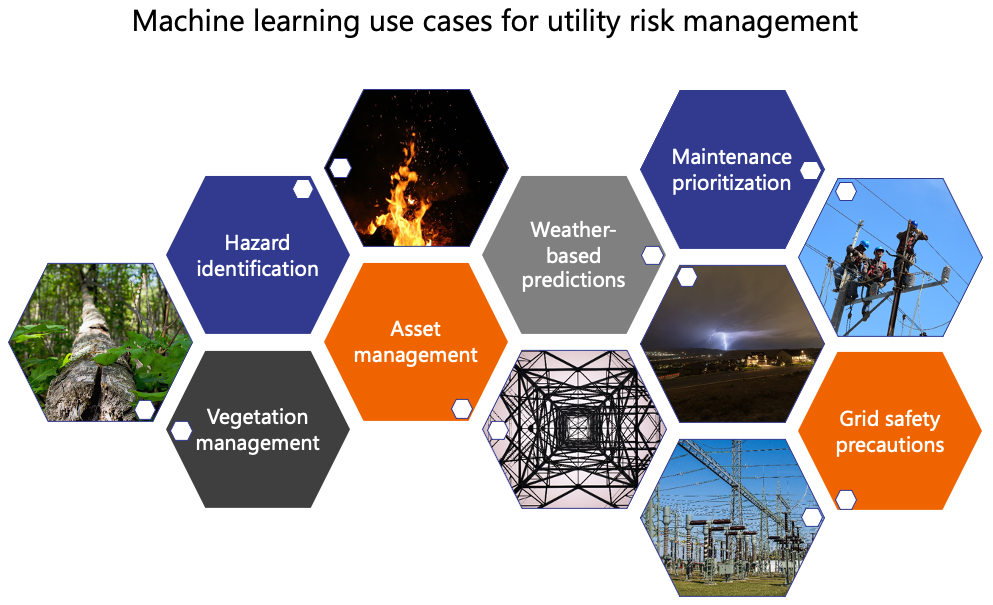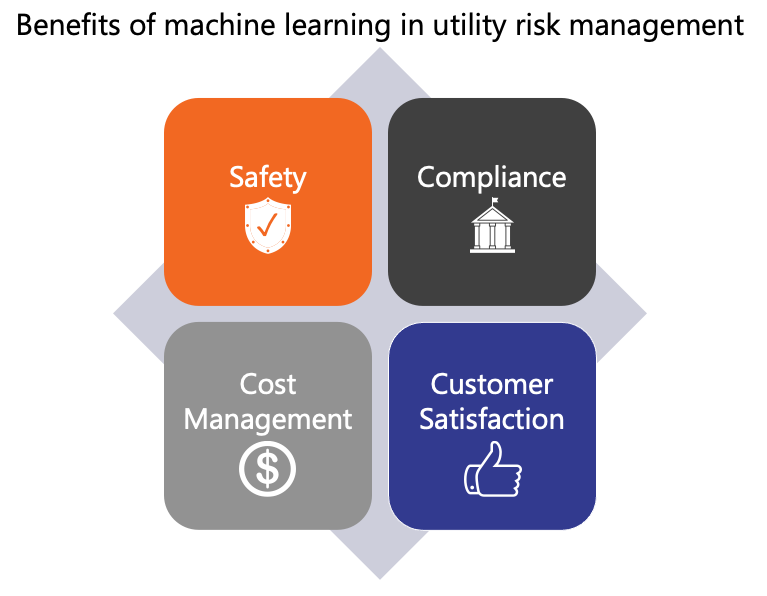8-minute read
Quick summary: Leveraging machine learning for risk management positions utilities to increase safety, improve regulatory compliance, manage costs, and improve service for their customers.
Driven by increasing compliance requirements, escalating customer expectations, and growing concerns over safety and grid reliability, utility companies are seeking innovative solutions for managing risk more effectively. They know the answers lie within their data—the challenge lies in discovering cost-efficient ways to make data work for them. That’s where machine learning (ML) comes in to support various analytics use cases in utilities.
Accelerating adoption of AI-driven solutions, particularly machine learning, enables utilities to tap into the power of their data in making mission-critical decisions. When utility companies implement machine learning to manage risk, they are better equipped to overcome the challenges of the current environment and to be ready for what lies ahead.
Machine learning enables utilities to tap into the power of data in making mission-critical decisions.
New disruptors, new challenges
While utilities may not be known for being early adopters of the latest innovations, some recent trends have forced even the most reluctant providers to rethink their perspectives on AI-driven automation.
Climate change–related events
As climate change continues to drive extreme weather events, utilities must adapt to the resulting demand spikes, outage risks, fire hazards, and other challenges. The western United States has been enduring a multi-year drought—at least half of the last 20 years have been drier than the long-term average—increasing demands on water utilities and escalating fire risks. In California alone, 7,386 fires were recorded in 2023, burning over 323,000 acres across the state. The year also saw record-setting tornado outbreaks, deadly wildfires in Hawaii, and an above-normal Atlantic hurricane season.
While the need to anticipate and prepare for severe weather is nothing new, the escalating frequency and intensity of climate crises is calling for the exploration of more effective solutions.
Article continues below.
WEBINAR
How asset image analytics supercharges utility operations
WHITE PAPER
Transforming utility operations with asset image analytics
Top 6 use cases for analytics in utilities’ risk management
Vegetation management
Using machine learning, utilities can assemble data from drone footage, climate conditions, inspection records, and tree species profiles in training machine learning models to assign risk scores to each individual tree. These models can then be used to prioritize trees for inspection, recommend optimal trimming clearances, and estimate the number of risk events prevented by well-planned trimming.
Predictive asset management
Machine learning solutions can take in huge volumes of equipment-related data—including brands/suppliers, dates of installation, weather conditions, maintenance records, and historical records of failures—to predict when a specific piece of equipment is at risk for failure.
Rapid hazard identification
With machine learning, utilities can review thousands of records from drone footage, lidar, GIS mapping, and scores of other sources to identify irregularities that could indicate safety hazards. Problematic records can be automatically flagged for closer analysis and remediation by human response teams.
Weather-based outage and demand predictions
Historical weather data can be combined with usage patterns, outage reports, and other data to help machine learning solutions identify weather patterns that are likely to lead to outages, surges in demand, and other situations.
Maintenance prioritization
Traditionally, many utilities have maintained their equipment according to a set schedule—or responded when the equipment failed. Machine learning enables them to assign priority to assets which, according to their age, surrounding weather conditions, and other factors, are at highest risk of failure. By assigning highest priority to the assets at highest risk, utilities can avoid failures that lead to outages and fire hazards—and possibly extend the lifespan of their equipment as well.
Guiding grid safety precautions
During extreme weather events, it may become necessary to shut down portions of an electrical grid as a safety precaution. Machine learning delivers the quick insights and predictions utilities need to identify and prioritize the areas at highest risk for safety issues under rapidly changing conditions and plan shutdowns accordingly.

Benefits of machine learning and analytics in utilities’ risk management
Because it combines a massive capacity for reviewing data and the ability to learn continuously from outcomes, machine learning is ideally suited for utilities looking to upscale their risk management practices in a cost-effective way. Utilities that are adding analytics and machine learning to their operations in various use cases are realizing an array of benefits.
Increased safety
Machine learning enables utilities to quickly identify and address potential safety hazards before they can cause damage or place communities at risk.
Improved compliance
Thanks to machine learning, utility companies can easily assemble the data they need to respond to compliance reporting requirements and ensure continued alignment with regulatory guidelines.
Improved cost management
Utilities can leverage data analytics and machine learning to save hundreds of hours on manual inspections, maintenance reports, and other tasks traditionally done by human employees.
Improved customer satisfaction
Every time an outage can be avoided, utility companies have an opportunity to increase satisfaction and trust among their customers.

Machine learning tools for effective risk management
Technology products alone will not guarantee optimal outcomes in machine learning—but it’s tough to be successful without the right combination of the right solutions.
At Logic20/20, we take a technology-agnostic approach to machine learning for our clients, tailoring each solution to the organization’s specific needs. Over the years, we’ve used various combinations of Palantir Foundry, AWS solutions (Amazon Athena, AWS Glue, Amazon SageMaker), Google Cloud products (Vertex AI, AutoML, AI Infrastructure), and Azure Machine Learning. Each solution offers its own advantages, so it’s important that we gain a deep understanding of the organization’s current situation and ultimate objectives before exploring specific technologies.
Before exploring technology platforms, it’s vital to understand the utility’s specific risk management goals.
Utilities analytics case studies
Logic20/20 has had the opportunity to support multiple utility companies in their missions to tap into the power of machine learning for their risk management initiatives.
Vegetation management plan validation
A large California utility needed to prove to the state utilities commission that their vegetation management program was effective in reducing fire risks. Our team developed a machine learning model to analyze the outcomes of the program. After analyzing more than 12.5 million records—encompassing factors such as line clearance distance and genus and location of trees—we delivered an analysis that provides the information needed for a data-driven, actionable wildfire mitigation plan.
Asset management
Identifying asset (equipment) risks is vital to maintaining grid safety; however, the task of continuously monitoring the condition of every piece of equipment across hundreds of miles lies beyond the realm of human capabilities. For an electricity provider serving more than 3 million customers, we developed deep neural networks to detect asset issues from drone footage, satellite images, lidar, and inspector photos, using image detection to improve issue capture rates and reduce inspection costs.
Looking ahead
As more utilities adopt machine learning, they become capable of going beyond traditional risk management (controlling the various things that could go wrong) to achieve true resilience—being ready to quickly recognize and respond to a wide range of situations.
While the growing use of predictive analytics in the energy industry makes this evolution possible, utilities must recognize the shift in mindset needed for a successful machine learning strategy. Utility companies have historically operated according to fixed plans, addressing risk management through rules and regulations. In an environment that’s increasingly dynamic and fluid, this approach can only go so far. When utilities leverage analytics in various use cases, they can achieve the agility they need to improve safety, control costs, manage compliance, and deliver more reliable service to their customers in a rapidly changing environment.

Powering a sustainable tomorrow
We partner with utilities to help them build a more resilient grid and move towards a cleaner, brighter future through
- Smart automation
- Asset image analytics
- DERMS implementation
- Analytics & predictive insights
- Cloud optimization

Adam Cornille is Director of Advanced Analytics at Logic20/20. He is a data science manager and practitioner with over a decade of field experience, and has trained in development, statistics, and management practices. Adam currently heads the development of data science solutions and strategies for improving business maturity in the application of data.

